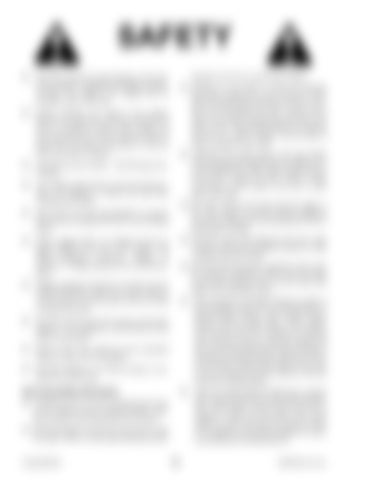SAFETY Ü
Ü
Ü NEVER use your hands to search for hydraulic fluid leaks. Instead use a piece of paper or cardboard. Escaping fluid under pressure can be invisible and can penetrate the skin, causing serious injury. If any fluid is injected into your skin, see a doctor at once. Injected fluid MUST be surgically removed by a doctor familiar with this type of injury or gangrene may result.
During transport, the length of the rigging between the attachment and load should be as short as possible to reduce booms height and movement. DO NOT raise the load more than 12 inches (305 mm) above the ground, or raise the boom more than 45 degrees.
Ü
Only lift the load vertically – NEVER drag it horizontally.
Ü
Use multiple pickup points on the load when possible. Use taglines to restrain the load from swinging and rotating.
Ü
Start, travel, turn and stop SLOWLY to prevent the load from swinging. DO NOT exceed walking speed.
Ü
Inspect rigging before use. Rigging must be in good condition and in the U.S. comply with OSHA regulation §1910.184, “Slings,” or §1926.251, “Rigging equipment for material handling.”
Ü
detailed in the Service and Storage chapter.
DO NOT exceed the rated capacity of the telescopic handler as equipped for handling suspended loads. The weight of the rigging must be included as part of the load.
Ü ALWAYS wear safety glasses with side shields when striking metal against metal. In addition, it is recommended that a softer (chip-resistant) material be used to cushion the blow. Failure to heed could lead to serious injury to the eyes or other parts of the body. Ü DO NOT refill the fuel tank when the engine is hot. Allow engine to cool down before refilling to prevent hot engine parts from igniting the fuel if it should spill or splash. Ü DO NOT smoke while filling the fuel tank, while working on the fuel or hydraulic systems, or while working around the battery. Ü DO NOT fill the fuel tank completely. Allow room for expansion. Maintain control of the fuel filler nozzle when filling the tank. Use the correct fuel grade for the operating season.
Rigging equipment attached to the forks must be secured such that it cannot move either sideways or fore and aft. The load center must not exceed 24 inches (610 mm).
Ü
DO NOT lift the load with anyone on the load, rigging or lift equipment, and NEVER lift the load over personnel.
Ü
Beware of the wind, which can cause suspended loads to swing, even with taglines.
Ü
DO NOT attempt to use frame-leveling to compensate for load swing.
Servicing Safety Reminders Ü ALWAYS be aware of and avoid pinch point areas on the machine, such as wheels-to-frame, cylinders-to-frame, boom-attachment-tool-to-frame. Ü NEVER attempt to by-pass the keyswitch to start the engine. ONLY use the jump-starting procedure
913323/DP0514
12
Ü
Static electricity can produce dangerous sparks at the fuel-filling nozzle. Do not wear polyester, or polyester-blend clothing while fueling. Before fueling, touch the metal surface of the machine away from the fuel fill to dissipate any built-up static electricity. Do not re-enter the machine but stay near the fuel filling point during refueling to minimize the build-up of static electricity. Do not use cell phones while fueling. Make sure the static line is connected from the machine to the fuel truck before fueling begins.
Ü
Ultra-Low Sulfur Diesel (ULSD) poses a greater static ignition hazard than earlier diesel formulations. Avoid death or serious injury from fire or explosion; consult with your fuel or fuel system supplier to ensure the entire fuel delivery system is in compliance with fueling standards for proper grounding and bonding practices.
PRINTED IN U.S.A.







